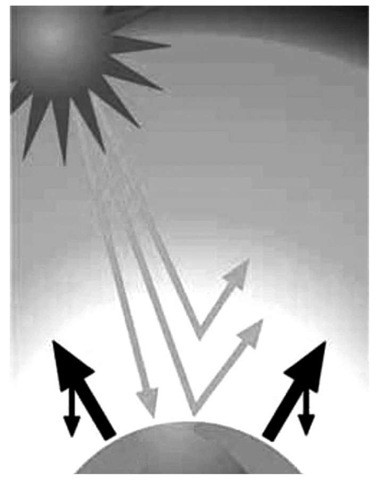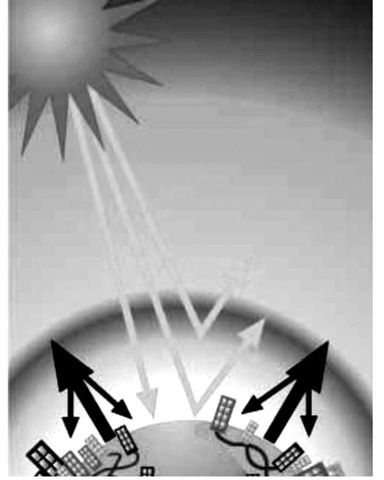Human activities can disrupt the balance of the natural system that regulates the temperature on Earth. This natural regulating system is known as the greenhouse effect. As human societies burn fossil fuels, and adopt it to increasingly sophisticated and mechanized lifestyles in the developed world, the amount of heat-trapping CO2 and CH4 in the atmosphere has increased. By increasing the amount of these heat-trapping gases in the atmosphere, humankind has enhanced the warming capability of the natural greenhouse effect.
This human influence (in addition to the natural release of these gases) on the natural warming function of the greenhouse effect has become known as the enhanced greenhouse effect. It is this human-induced enhanced greenhouse effect that causes environmental concern. This enhanced greenhouse effect has the potential to warm the planet at a rate that is unprecedented. Greenhouse gas effects due to natural phenomena have existed from the very beginning of the Earth. The rate has increased over time due to increased human activity such as industrialization, deforestation, increased fossil-fuel-based transportation, and increased agriculture to satisfy the increased population.
Most of Earth’s heat is re-radiated toward space, but some is trapped by greenhouse gases in the atmosphere. This is a natural effect that keeps Earth’s temperature at a level necessary to support life.
Another factor that is causing significant change in the atmosphere is the rising levels of carbon dioxide, due to increased burning of coal and oil, which traps more heat in the atmosphere, thus warming the Earth. This phenomenon began with the advent of the Industrial Revolution of 1800s, and has been increasing ever since. Work was done by hand and by animal power before the Industrial Revolution, but was done by fossil-fuel burning machines since the Industrial Revolution, resulting in generation of higher amounts of CO2 and its subsequent release to the environment. It is difficult to predict the precise effects of doubling the concentration of CO2 in the atmosphere, but doubling CO2 should increase global temperatures.
Human activity—particularly burning fossil fuels (coal, oil, and natural gas) and land clearing—is generating more greenhouse gases. Scientists are convinced that this will trap more heat and raise Earth’s surface temperature.
Also, increased production of rice and growing numbers of domestic animals to feed the increasing population have resulted in increased emissions of CH4. During the last two centuries, the concentrations of CO2 and CH4 (both greenhouse gases) have increased faster than at any other time in the recorded history of mankind, leading to enhanced greenhouse effect.
Results of enhanced greenhouse effect
The expected continued temperature rise due to climate change is linked to the observed buildup of greenhouse gases in the atmosphere. This will cause further warming of Earth’s surface over the long term. Whether or not global warming has already begun, and if it is a direct result of the enhanced greenhouse effect, is still uncertain. The Intergovernmental Panel on Climate Change (IPCC) raised the question through the fourth report of IPCC to the United Nations (UN) in 2007. The IPCC’s chairperson commented that the world still has time to reverse global warming. The decision by the Nobel Peace Prize committee to award the 2007 prize to the UN IPCC, together with former U.S. Vice President Al Gore, demonstrates that the committee considers climate change a threat to peace and that the global warming is taking place.
The enhanced greenhouse effect has already led to some severe weather patterns such as: 11 of the last 12 years (1995-2006) rank among the 12 warmest years ever recorded since global surface temperatures were measured (1850). Over the last 100 years (1906-2005), there has been an increase in surface temperature of 1.3 degrees F (0.74 degrees C), which is larger than the 1 degree F (0.6 degrees C) increase given in the Third Assessment Report for the 19012000 period. And the warming trend over the last 50 years (.23 degrees F, or 0.13 degrees C per decade) is nearly twice that for the last 100 years.
Temperatures in the higher atmosphere and in the oceans (to depths of at least 1.8 mi. or 3,000 m.) have also been rising, along with the water vapor content of the atmosphere. Mountain glaciers, snow cover, and ice caps have declined, on average, in both hemispheres, contributing, in part, to the rise of global sea level. The Arctic and Antarctic ice caps have also contributed to the observed rise of sea level, which amounted to a rise of 6.6 in. (17 cm.) in total over the course of the 20th century.
At continental, regional, and ocean-basin scales, numerous long-term changes in climate have been observed. These include changes in Arctic temperatures and ice, widespread changes in precipitation amounts, ocean salinity, wind patterns, and aspects of extreme weather including droughts, heavy precipitation, heatwaves, and the intensity of tropical cyclones. Some aspects of climate have not been observed to change. The difference of temperature between day and night, for example, has remained the same, since daytime and nighttime temperatures have risen by the same amount. However, even when expected natural short-term variability, such as unusually cold winters are taken into account, global temperature trends show that the Earth has warmed over the long term.
To summarize, the enhanced greenhouse effect is leading to change in atmospheric composition and climate change during the 20th century: global-average surface temperature has increased (1 degree F, or 0.6 degrees C); temperature in the lowest 8 km. increased in the past four decades, global-average sea level has risen (0.3-0.6 ft., or 0.1-0.2 m.), snow and ice extent decreased with widespread retreat of glaciers, and precipitation has increased (up to 1 percent per decade).
Since 1750, there has been an increase of: CO2 (31 percent), CH4 (151 percent) and N2O (17 percent), and present CO2 levels probably were not exceeded in the past 20,000 years.


